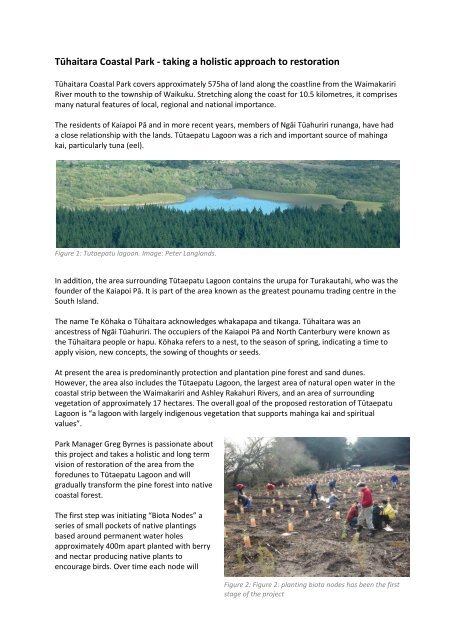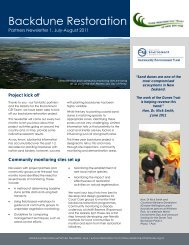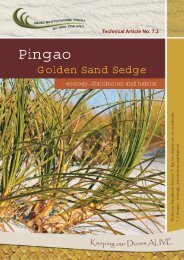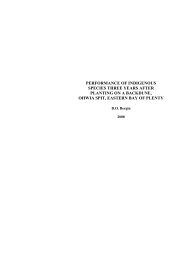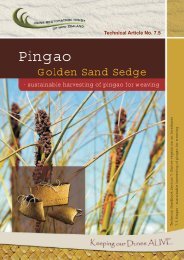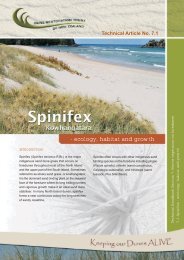Te Kohaka o Tuhaitara full article.pdf - Dune Restoration Trust
Te Kohaka o Tuhaitara full article.pdf - Dune Restoration Trust
Te Kohaka o Tuhaitara full article.pdf - Dune Restoration Trust
You also want an ePaper? Increase the reach of your titles
YUMPU automatically turns print PDFs into web optimized ePapers that Google loves.
Tūhaitara Coastal Park - taking a holistic approach to restorationTūhaitara Coastal Park covers approximately 575ha of land along the coastline from the WaimakaririRiver mouth to the township of Waikuku. Stretching along the coast for 10.5 kilometres, it comprisesmany natural features of local, regional and national importance.The residents of Kaiapoi Pā and in more recent years, members of Ngāi Tūahuriri runanga, have hada close relationship with the lands. Tūtaepatu Lagoon was a rich and important source of mahingakai, particularly tuna (eel).Figure 1: Tutaepatu lagoon. Image: Peter Langlands.In addition, the area surrounding Tūtaepatu Lagoon contains the urupa for Turakautahi, who was thefounder of the Kaiapoi Pā. It is part of the area known as the greatest pounamu trading centre in theSouth Island.The name <strong>Te</strong> Kōhaka o Tūhaitara acknowledges whakapapa and tikanga. Tūhaitara was anancestress of Ngāi Tūahuriri. The occupiers of the Kaiapoi Pā and North Canterbury were known asthe Tūhaitara people or hapu. Kōhaka refers to a nest, to the season of spring, indicating a time toapply vision, new concepts, the sowing of thoughts or seeds.At present the area is predominantly protection and plantation pine forest and sand dunes.However, the area also includes the Tūtaepatu Lagoon, the largest area of natural open water in thecoastal strip between the Waimakariri and Ashley Rakahuri Rivers, and an area of surroundingvegetation of approximately 17 hectares. The overall goal of the proposed restoration of TūtaepatuLagoon is “a lagoon with largely indigenous vegetation that supports mahinga kai and spiritualvalues”.Park Manager Greg Byrnes is passionate aboutthis project and takes a holistic and long termvision of restoration of the area from theforedunes to Tūtaepatu Lagoon and willgradually transform the pine forest into nativecoastal forest.The first step was initiating “Biota Nodes” aseries of small pockets of native plantingsbased around permanent water holesapproximately 400m apart planted with berryand nectar producing native plants toencourage birds. Over time each node willFigure 2: Figure 2: planting biota nodes has been the firststage of the project
slowly increase as will the plant species. Birds will help with the transfer and propagation of nativespecies between these nodes.Schools and various community groups adopt anode, establish plants and provide the on-goingmaintenance. Our two main school biota nodesTamariki of Woodend and <strong>Te</strong> Puawaitanga oTuahiwi are about to extend further into the backdunes and heading for the fore dunes. We areabout to start our first node at The Pines Beach.We have been in contact with Kaiapoi NorthSchool, and it looks like they will be involved withthis so very exciting. We have now completed ourbiota node learning resource and will belaunching versions in both English and Māori inthe near future.The Biota Node project is also part of the <strong>Dune</strong>s <strong>Trust</strong>’s Back <strong>Dune</strong> Project with valuable researchcarried out on restoring back dune ecosystems.This year the first Kowhangatara (Spinifex sericeus) was reintroduced after being extinct along thiscoastline for over 100 years with over 2000 planted at Woodend Beach the significance of this wasvery apparent to <strong>Dune</strong>s <strong>Trust</strong> <strong>Trust</strong>ee Greg Bennett who admitted getting quite emotional about it.2013 <strong>Dune</strong>s <strong>Trust</strong> Best <strong>Restoration</strong> Project AwardTūhaitara Coastal Park is a very worthy recipient of the Best Project Award and will provide a rangeof opportunities to preserve Ngāi Tahu values, retain and enhance rare indigenous biodiversity andprovide recreational and educational opportunities for all people for generations in the future.


